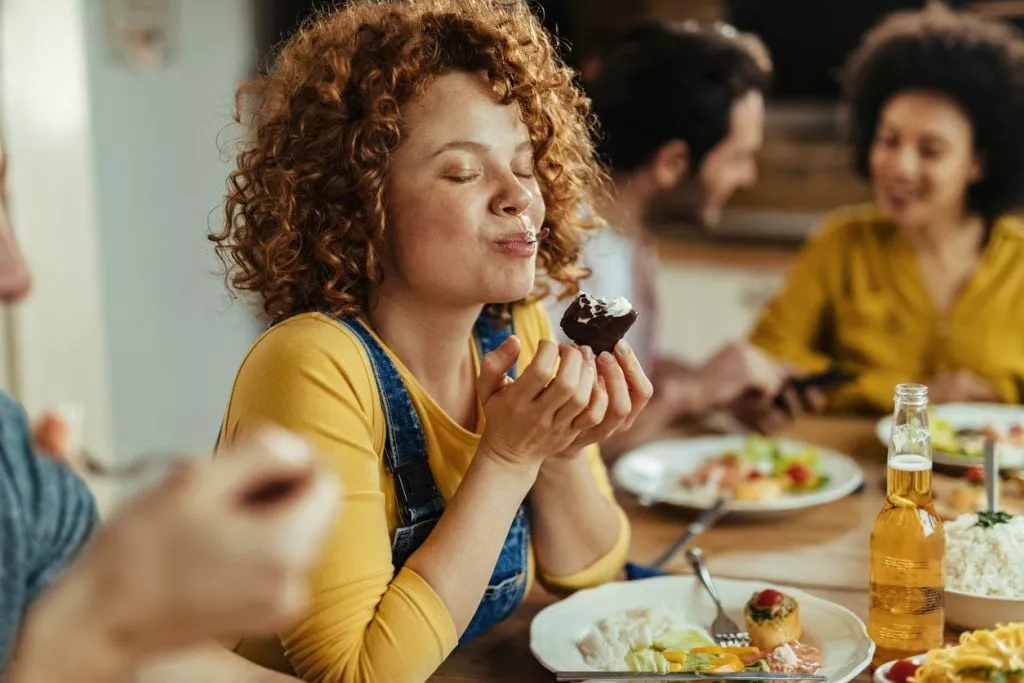If you're human, chances are you've experienced food cravings. Whether it’s an overwhelming desire for your favorite dessert or the comforting pull of mom’s cooking, cravings can arise from various places. While nutritional needs might drive some cravings, many have deeper emotional roots.
Instead of seeing cravings as obstacles to overcome, they can be insightful indicators of unmet needs hiding beneath the surface. Here’s how to extract the wisdom behind your cravings to foster a healthier relationship with food.
Why food cravings aren’t the enemy
Diet culture often convinces us that cravings are something to control or resist. But what if we approached them differently? Cravings can often reveal underlying feelings and stressors that may need addressing.
Geneen Roth, an author and speaker, advocates for an intuitive approach to food cravings, viewing them as a pathway to liberation. In her book, Women, Food, and God: An Unexpected Path to Almost Everything, Roth emphasizes that dieting is often rooted in a sense of inner lack rather than food itself.

She teaches that embracing our food desires as natural and safe helps reclaim our inner voice, often drowned out by societal pressures.
Rather than restrictive dieting, intuitive eating invites us to celebrate and enjoy our desires. According to a 2021 review, intuitive eating is recognized as a beneficial mental health strategy linked to positive outcomes like enhanced:
Positive body image
Self-esteem
Overall well-being
A 2020 study tracked 1,491 participants from adolescence into young adulthood. After eight years, those who continued to practice intuitive eating showed lower instances of disordered eating behaviors, including:
High depressive symptoms
Low self-esteem
High body dissatisfaction
Unhealthy weight control behaviors (e.g., fasting, skipping meals)
Extreme weight control behaviors (e.g., using diet pills or vomiting)
Binge eating
Dieting often centers around an inner sense of lack rather than actual food or weight loss. By embracing the natural, safe desire for food, we can reclaim our inner voice that often gets drowned out by diet culture’s messaging.
“It’s never been true, not anywhere at any time, that the value of a soul, of a human spirit, is dependent on a number on a scale,” writes Roth. “When we start defining ourselves by that which can be measured or weighed, something deep within us rebels.”

Geneen Roth
Similarly, food freedom and holistic wellness coach Sloane Elizabeth turned her own struggles with food into a desire to help others.
“I had my own history with disordered eating and body image struggles, and that’s what ultimately inspired me to help other women,” she shares.
For Elizabeth, food cravings masked her fear of losing control.
“I realized that it wasn’t really about the food at all, but it was about control issues and perfectionism,” she explains. “Food just so happened to be the thing that I used to express that fear.”
The truth underneath compulsion
If food cravings cover deeper emotions, trying to repress or control them won’t solve the issue. A 2020 review showed that avoiding certain foods actually increases cravings for them. These cravings can be conditioned responses stemming from learned cues rather than deficiencies.
While identifying these cues is complex, they often tie back to emotional factors. The root issues might be fears of unlovability, unworthiness, perfectionism, or a lack of control.
To get to the core of your food desires, engage with and listen to your cravings. Recognize that food won’t fix everything—this notion is a lie.
Instead of superficial changes, like swapping a cookie for a rice cake, face the real reasons you turn to food for comfort.
Once confronted, your obsession with food can lessen.
“When you no longer believe that eating will save your life when you feel exhausted or overwhelmed or lonely, you will stop,” Roth says. “When you believe in yourself more than you believe in food, you will stop using food as if it were your only chance at not falling apart.”
7 techniques to learn from food cravings
Now that you understand cravings may conceal deeper emotions, what should you do next?
The following techniques can help you uncover the wisdom behind your eating desires.
1.Sit with the craving
Cravings are natural and should be acknowledged rather than ignored or immediately satisfied.
Sit with the craving, feel where it is in your body, and notice what sensations or memories arise. Ask yourself where the craving originates without trying to figure it out.
After exploring the craving, consider if it can be addressed in other ways: drinking water, taking a nap, going for a walk, calling a friend, or enjoying a warm bath. You might find that the specific food craving isn’t as intense as you thought.
2.Be aware of the belly
Focus on your belly, an area many tend to hide or ignore.
“You begin the process of bringing yourself back to your body, to your belly, to your breath because they…are here now,” writes Roth. “It is only here, only now that you can make a decision to eat or not eat.”
Delegate the decision-making
The question of “Should I eat or not?” can cause spirals of overwhelm. Instead, delegate the task.
Trust your body to manage cravings without needing to control every decision. “If you can…believe that everything is under control, instead of you being in control, then there’s a lot more peace,” Elizabeth advises.
Learn your cues
Practice sitting with your cravings to interpret your body’s signals. The more you practice, the better you’ll become at recognizing your cues.
3.Celebrate your cravings
Instead of fearing cravings, Elizabeth encourages you to celebrate them.
A craving is a form of communication from your body, a connection that should be cherished.
Ask ‘what else am I hungry for?’
Dig deeper into your cravings. If you’re craving cake for breakfast, explore what you might truly need, such as love, comfort, or validation.
4.Keep the food you crave in the house
Contrary to common advice, having your desired foods available can help normalize them.
Limiting your cravings to specific times can heighten their intensity, so allow yourself to indulge throughout the week.
Tips for enjoying your food
Eat when you are hungry
Eat sitting down in a calm environment (not in the car)
Eat without distractions (like TV or intense conversations)
at what your body wants
Eat until you are satisfied
Eat in full view of others
Eat with enjoyment and pleasure
By following these tips, you can experience the pleasure of eating without guilt or shame.
Takeaway
“When we give up dieting, we take back something we were often too young to know we had given away: our own voice,” Roth writes.
By listening to your cravings and treating them with curiosity and respect, you can start reclaiming that voice.









COMMENTS
Comments are moderated and generally will be posted if they are on-topic and not abusive.
For more information, please see our Comments FAQ